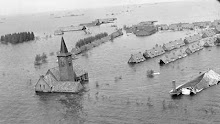Life list now 167 species
>>Egypt
Port Said is the port on the Mediterranean Sea at the northern end of the Suez Canal and Suez is the port at the southern end. Arrival in Port Said was my introduction to Africa, and the start of a 64-year long love affair with that continent (though I did not know it then).
"Entered the harbour about 0900, disembarked at 1300, left by train for Kasfareit (c. 25 miles north of Suez) at 1630, arriving there after dark (2030).>>>
In the sea and Port Said harbour were mostly gulls, early on, mainly Lesser Black-backed Gulls (Larus fuscus) of two or three subspecies: Scandinavian, Siberian and British. I found it difficult to decide upon the exact identity of these birds. Only a very few had wing-coverts, mantle and primaries of the same colour exactly. These were obviously of the Scandinavian form. Many, which, at first sight, seemed to be of this variety, upon closer inspection and at certain angles, were seen to have a slight but quite noticeable difference between the shade of their wing tips and other dark parts of their plumage. I took these to be the Siberian form. A good number, too, were pretty obviously different and presumably of the British subspecies. The mantle and coverts were approx. half-way between the shade of the dark form and that of the Yellow-legged Gull. Approx proportions were Siberian 70%, British 25%, Scandinavian 5%. Herring Gulls were much more numerous in the harbour than outside.
An unidentified bird flew around the ship several times and settled on the sea (same bird?) The bird in flight was white beneath and black (or very dark) above with a white wing bar and resembled a wader of Redshank size. The floating bird was black or very dark above and probably on the head, and white below.
From the boat I saw many pigeons (domesticated) in flight and some Egyptian House Sparrows (P. d. niloticus).
I took down a detailed description of the Egyptian Black Kite* as, at the time, I could not identify it. However, since then I have had access to reference books and find it to be Milvus migrans aegyptius. It is very numerous indeed over all areas of habitation in Egypt and I will omit further unneccessary references to it.
Two or three [Barn] Swallows of unknown subspecies (I do not even know if underparts were white or red but probably the former) flew over us in the train and at several other places I saw a few.
One or two Kestrels (or Lesser Kestrels) were seen near Port Said.
Over Port Said were plenty of Hooded Crows (C. corone pallescens/sardonnis). Later, at Kasfereit, there were more of these as well as Brown-necked Ravens* (Corvus [corax] ruficollis). These greatly resembled Carrion Crows at any distance when the brown was not visible.
There were great numbers of waders in various spots on the mud beside the railway line. Most seemed Redhanks or Greenshanks or possibly godwits and some smaller types as well. However, the train was going too fast and rocking considerably, the sun was in my eyes, and I could not be sure of a single species. c. 500 ducks were put up by the train but, again, at too great a range for me. I saw one Pied Kingfisher* (Ceryl rudis) on the wires beside the line.
A chap pointed out several (c. 12) birds in a palm tree. At first I thought they were white pigeons but the, through my binocs, saw long pointed yellow bills and a general heron-like appearance, particularly of one in flight. They were apparently Buff-backed Herons [Cattle Egrets*] (Ardeola ibis)."
Subscribe to:
Comments (Atom)

